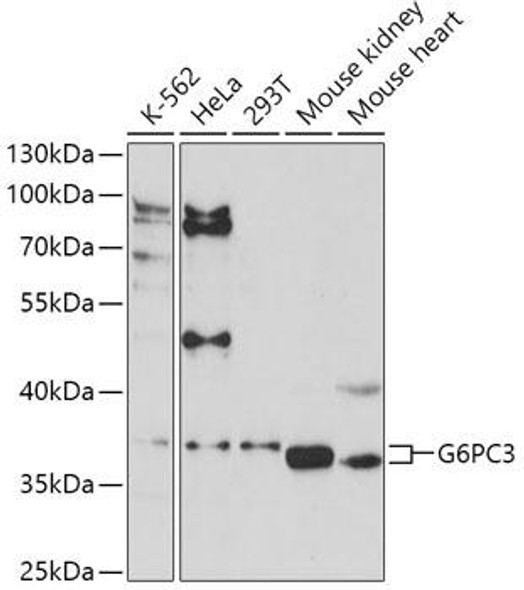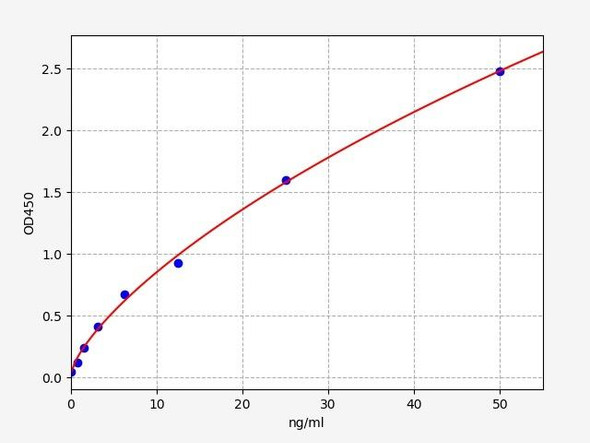Description
| Product Name: | G6PC Rabbit pAb |
| Product Code: | CAB20193 |
| Size: | 50uL, 100uL |
| Synonyms: | G6pt, G6Pase, AW107337, Glc-6-Pase |
| Applications: | WB, IF |
| Reactivity: | Mouse |
| Host Species: | Rabbit |
| Immunogen: | A synthetic peptide of Mouse G6PC. |
| Applications: | WB, IF |
| Recommended Dilutions: | WB 1:1000 - 1:2000 IF 1:50 - 1:200 |
| Reactivity: | Mouse |
| Positive Samples: | Mouse liver, Mouse kidney |
| Immunogen: | A synthetic peptide of Mouse G6PC. |
| Purification Method: | Affinity purification |
| Storage: | Store at -20°C. Avoid freeze / thaw cycles. Buffer: PBS with 0.02% sodium azide, 50% glycerol, pH7.3. |
| Isotype: | IgG |
| Sequence: | Email for sequence |
| Gene ID: | 14377 |
| Uniprot: | P35576 |
| Calculated MW: | 40kDa |
| Observed MW: | 40KDa |
| UniProt Protein Function: | G6PC: Hydrolyzes glucose-6-phosphate to glucose in the endoplasmic reticulum. Forms with the glucose-6-phosphate transporter (SLC37A4/G6PT) the complex responsible for glucose production through glycogenolysis and gluconeogenesis. Hence, it is the key enzyme in homeostatic regulation of blood glucose levels. Defects in G6PC are the cause of glycogen storage disease type 1A (GSD1A). A metabolic disorder characterized by impairment of terminal steps of glycogenolysis and gluconeogenesis. Patients manifest a wide range of clinical symptoms and biochemical abnormalities, including hypoglycemia, severe hepatomegaly due to excessive accumulation of glycogen, kidney enlargement, growth retardation, lactic acidemia, hyperlipidemia, and hyperuricemia. Belongs to the glucose-6-phosphatase family. |
| UniProt Protein Details: | Protein type:Phosphatase (non-protein); Carbohydrate Metabolism - galactose; Membrane protein, multi-pass; Carbohydrate Metabolism - starch and sucrose; EC 3.1.3.9; Endoplasmic reticulum; Transporter, SLC family; Carbohydrate Metabolism - glycolysis and gluconeogenesis; Membrane protein, integral; Transporter Cellular Component: membrane; intracellular membrane-bound organelle; endoplasmic reticulum; integral to membrane; integral to endoplasmic reticulum membrane Molecular Function:hydrolase activity; glucose-6-phosphatase activity; phosphate binding; phosphotransferase activity, alcohol group as acceptor; catalytic activity Biological Process: glycogen metabolic process; steroid metabolic process; phosphorylated carbohydrate dephosphorylation; glycogen catabolic process; multicellular organism growth; glucose 6-phosphate metabolic process; lipid homeostasis; glucose homeostasis; phosphate metabolic process; gluconeogenesis; cholesterol homeostasis; urate metabolic process; triacylglycerol metabolic process; dephosphorylation; regulation of gene expression; glucose-6-phosphate transport |
| UniProt Code: | P35576 |
| NCBI GenInfo Identifier: | 31982353 |
| NCBI Gene ID: | 14377 |
| NCBI Accession: | NP_032087.2 |
| UniProt Secondary Accession: | P35576,Q91WV3, |
| UniProt Related Accession: | P35576 |
| Molecular Weight: | 40,473 Da |
| NCBI Full Name: | glucose-6-phosphatase |
| NCBI Synonym Full Names: | glucose-6-phosphatase, catalytic |
| NCBI Official Symbol: | G6pc |
| NCBI Official Synonym Symbols: | G6pt; G6Pase; AW107337; Glc-6-Pase |
| NCBI Protein Information: | glucose-6-phosphatase; G-6-Pase; Glc-6-Pase-alpha |
| UniProt Protein Name: | Glucose-6-phosphatase |
| Protein Family: | Glucose-6-phosphatase |
| UniProt Gene Name: | G6pc |
| UniProt Entry Name: | G6PC_MOUSE |






